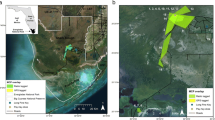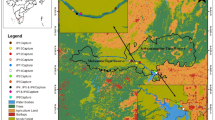Abstract
The “Judas” technique is based on the idea that a radio-tagged individual can be used to “betray” conspecifics during the course of its routine social behavior. The Burmese python (Python bivittatus) is an invasive constrictor in southern Florida, and few methods are available for its control. Pythons are normally solitary, but from December–April in southern Florida, they form breeding aggregations containing up to 8 individuals, providing an opportunity to apply the technique. We radio-tracked 25 individual adult pythons of both sexes during the breeding season from 2007–2012. Our goals were to (1) characterize python movements and determine habitat selection for betrayal events, (2) quantify betrayal rates of Judas pythons, and (3) compare the efficacy of this tool with current tools for capturing pythons, both in terms of cost per python removed (CPP) and catch per unit effort (CPUE). In a total of 33 python-seasons, we had 8 betrayal events (24 %) in which a Judas python led us to new pythons. Betrayal events occurred more frequently in lowland forest (including tree islands) than would be expected by chance alone. These 8 events resulted in the capture of 14 new individuals (1–4 new pythons per event). Our effort comparison shows that while the Judas technique is more costly than road cruising surveys per python removed, the Judas technique yields more large, reproductive females and is effective at a time of year that road cruising is not, making it a potential complement to the status quo removal effort.




Similar content being viewed by others
References
Bajer PG, Chizinski CJ, Sorensen PW (2011) Using the Judas technique to locate and remove wintertime aggregations of invasive common carp. Fish Manag Ecol 18:497–505
Branch B, Erasmus H (1984) Captive breeding of pythons in South Africa, including details of an interspecific hybrid (Python sebae natalensis x Python molurus bivitattus). Afr J Herpetol 30:1–10
Campbell K, Donlan CJ, Cruz F et al (2004) Eradication of feral goats Capra hircus from Pinta Island, Galápagos, Ecuador. Oryx 38:328–333
Campbell KJ, Baxter GS, Murray PJ et al (2005) Increasing the efficacy of Judas goats by sterilisation and pregnancy termination. Wildl Res 32:737–743
Carrick P, Thomson D, Calley G (1990) The use of radio transmitters for tracking and shooting feral buffalo. Rangel J 12:84–90
Carrion V, Donlan CJ, Campbell KJ, et al. (2011) Archipelago-wide island restoration in the Galapagos Islands: reducing costs of invasive mammal eradication programs and reinvasion risk. Plos One 6:e18835
Clout M, Veitch C (2002) Turning the tide of biological invasion: the potential for eradicating invasive species. In: Veitch C, Clout M (eds) Turning the tide: the eradication of invasive species. IUCN SSC Invasive Species Specialist Group, Gland, Switzerland, pp 1–3
Cruz F, Carrion V, Campbell KJ et al (2009) Bio-economics of large-scale eradication of feral goats from Santiago Island, Galápagos. J Wildl Manag 73:191–200
Davis JH (1943) The natural features of southern Florida. Fla Geol Surv Bull 25:31
Dorcas ME, Willson JD (2013) Hidden giants: problems associated with studying secretive invasive pythons. In: Lutterschmidt WI (ed) Reptiles in research: investigations of ecology, physiology, and behavior from desert to sea. Nova Science Publishers Inc, Hauppage, pp 367–385
Dorcas ME, Willson JD, Reed RN et al (2012) Severe mammal declines coincide with proliferation of invasive Burmese pythons in Everglades National Park. Proc Natl Acad Sci USA 109:2418–2422
Dove CJ, Snow RW, Rochford MR et al (2011) Birds consumed by the invasive Burmese python (Python molurus bivittatus) in Everglades National Park, Florida, USA. Wilson J Ornithol 123:126–131
Engeman RM, Vice DS (2001) Objectives and integrated approaches for the control of brown tree snakes. Integr Pest Manag Rev 6:59–76
Greene DU, Potts JM, Duquesnel JG et al (2007) Python molurus bivittatus (Burmese python). Herpetol Rev 38:355
Groombridge B, Luxmoore R (1991) Pythons in South-East Asia: a review of distribution, status, exploitation and trade in three selected species. CITES, Lausanne, p 140
Hart KM, Cherkiss MS, Smith BJ et al (2015) Home range, habitat use, and movement patterns of non-native Burmese pythons in Everglades National Park, Florida, USA. Anim Biotelemetry 3:8
Hunter ME, Oyler-McCance SJ, Dorazio RM et al (2015) Environmental DNA (eDNA) sampling improves occurrence and detection estimates of invasive Burmese pythons. Plos One 10:e0121655
Keegan DR, Coblentz BE, Winchell CS (1994) Feral goat eradication on San Clemente Island, California. Wildl Soc B 22:56–61
Kettenring KM, Adams CR (2011) Lessons learned from invasive plant control experiments: a systematic review and meta-analysis. J Appl Ecol 48:970–979
Kraus F (2009) Alien reptiles and amphibians: a scientific compendium and analysis. Springer, New York
Krysko KL, Burgess JP, Rochford MR, et al. (2011) Verified non-indigenous amphibians and reptiles in Florida from 1863 through 2010: outlining the invasion process and identifying invasion pathways and stages. Zootaxa 3028:1–64
Krysko KL, Hart KM, Smith BJ et al (2012) Record length, mass, and clutch size in the nonindigenous Burmese python, Python bivittatus Kuhl 1820 (Squamata: Pythonidae), in Florida. IRCF Reptiles Amphib 19:267–270
Lederer G (1956) Fortpflanzungsbiologie und entwicklung von Python molurus molurus (Linné) und Python molurus bivittatus (Kühl). Die Aquarien-Und Terrarien-Zeitschrift 9:243–248
Mazzotti FJ, Cherkiss MS, Hart KM et al (2011) Cold-induced mortality of invasive Burmese pythons in south Florida. Biol Invasions 13:143–151
McCann BE, Garcelon DK (2008) Eradication of feral pigs from Pinnacles National Monument. J Wildl Manag 72:1287–1295
McCleery RA, Sovie A, Reed RN, et al. (2015) Marsh rabbit mortalities tie pythons to the precipitous decline of mammals in the Everglades. Proc R Soc Lond [Biol] 282:20150120
McIlroy JC, Gifford EJ (1997) The ‘Judas’ pig technique: a method that could enhance control programmes against feral pigs, Sus scrofa. Wildl Res 24:483–491
Meshaka W, Loftus WF, Steiner T (2000) The herpetofauna of Everglades National Park. Fla Sci 63:84–103
Nugent G, Yockney IJ, Whitford EJ et al (2014) Assessing the effectiveness of tuberculosis management in brushtail possums (Trichosurus vulpecula), through indirect surveillance of Mycobacterium bovis infection using released sentinel pigs. Vet Med Int 2014:13
Pimentel D (2007) Environmental and economic costs of vertebrate species invasions into the United States. In: Witmer GW, Pitt WC, Fagerstone KA (eds) Managing vertebrate invasive species. USAD National Wildlife Research Center, Fort Collins
Pope CH (1961) The giant snakes. Routledge & Kegan Paul, London
R Core Team R (2014) R: a language and environment for statistical computing. R Foundation for Statistical Computing, Vienna
Rainbolt RE, Coblentz BE (1999) Restoration of insular ecosystems: control of feral goats on Aldabra Atoll, Republic of Seychelles. Biol Invasions 1:363–375
Reed RN, Kraus F (2010) Invasive reptiles and amphibians: global perspectives and local solutions. Anim Conserv 13:3–4
Reed RN, Rodda GH (2009) Giant constrictors: biological and management profiles and an establishment risk assessment for nine large species of pythons, anacondas, and the boa constrictor. US Geological Survey Open-File Report, Fort Collins
Reed RN, Hart KM, Rodda GH et al (2011) A field test of attractant traps for invasive Burmese pythons (Python molurus bivittatus) in southern Florida. Wildl Res 38:114–121
Rochford M, Brien M, Carrigan J et al (2009) Python molurus bivittatus (Burmese Python) Clutch Size. Herpetol Rev 40:442
Rochford M, Krysko K, Nifong J et al (2010) Python molurus bivittatus (Burmese Python). Diet Herpetol Rev 41:97
Rodda GH, Sawai Y, Chiszar D et al (1999) Problem snake management: the habu and the brown treesnake. Comstock Publishing Associates, Ithaca
RStudio Team (2015) RStudio: integrated development for R. RStudio Inc, Boston
Scholte EJ, Hartog Wd, Dik M et al (2010) Introduction and control of three invasive mosquito species in the Netherlands, July–October 2010. Eurosurveillance 15:19710
Smith BJ, Rochford MR, Brien M et al (2015) Largest breeding aggregation of Burmese Pythons (Python bivittatus) Kuhl 1820 (Squamata: Pythonidae) and implications for potential development of a control tool. IRCF Reptiles Amphib 22:16–19
Snow R, Krysko K, Enge K et al (2007a) Introduced populations of Boa constrictor (Boidae) and Python molurus bivittatus (Pythonidae) in southern Florida. In: Henderson RW, Powell R (eds) Biology of boas and pythons. Eagle Mountain Publishing, Eagle Mountain, pp 365–386
Snow RW, Brien ML, Cherkiss MS, et al. (2007b) Dietary habits of the Burmese python, Python molurus bivittatus, in Everglades National Park, Florida. Herpetol Bull 101:5–7
Spencer PBS, Hampton JO, Pacioni C et al (2015) Genetic relationships within social groups influence the application of the Judas technique: a case study with wild dromedary camels. J Wildl Manag 79:102–111
Taylor D, Katahira L (1988) Radio telemetry as an aid in eradicating remnant feral goats. Wildl Soc B 16:297–299
Wall F (1921) Ophidia taprobanica or the snakes of Ceylon. H. R. Cottle, Govt Printer, Colombo
Whitaker R, Captain A, Ahmed F (2004) Snakes of India: the field guide. Draco Books, Chennai
Wilcox JT, Aschehoug ET, Scott CA et al (2004) A test of the Judas technique as a method for eradicating feral pigs. Trans West Sect Wildl Soc 40:120–126
Willson JD, Dorcas ME, Snow RW (2011) Identifying plausible scenarios for the establishment of invasive Burmese pythons (Python molurus) in Southern Florida. Biol Invasions 13:1493–1504
Willson JD, Snow RW, Reed RN et al (2014) Python molurus bivittatus (Burmese Python). Minimum size at maturity. Herpetol Rev 45:343–344
Woolnough AP, Lowe TJ, Rose K (2006) Can the Judas technique be applied to pest birds? Wildl Res 33:449–455
Zhao E-M, Adler K (1993) Herpetology of China. Society for the Study of Amphibians and Reptiles in cooperation with Chinese Society for the Study of Amphibians and Reptiles, Oxford
Acknowledgments
All python radio-tracking was permitted under University of Florida animal care protocols F162 and 009-08-FTL, Florida Fish and Wildlife Conservation Commission permit ESC 08-02, and National Park Service (Everglades) permits EVER-2007-SCI-001, EVER-2009-SCI-001, and EVER-2011-SCI-0002. We thank M. Brien, J. Carrigan, A. Crowder, S. Gonzalez, B. Greeves, T. Hill, B. Jeffery, T. Kieckhefer, M. Parry, T. Walters, A. Wolf, and others for assistance in the field. Two anonymous reviewers, Associate Editor F. Kraus, and B. Falk provided valuable reviews that greatly improved this manuscript. Funding was provided by the National Park Service and the USGS Priority Ecosystem Science Program. References to non-USGS products and services are provided for information only and do not constitute endorsement or warranty, expressed or implied, by the U.S. Government, as to their suitability, content, usefulness, functioning, completeness, or accuracy. Any use of trade, product, or firm names is for descriptive purposes only and does not imply endorsement by the U.S. Government.
Author information
Authors and Affiliations
Corresponding author
Rights and permissions
About this article
Cite this article
Smith, B.J., Cherkiss, M.S., Hart, K.M. et al. Betrayal: radio-tagged Burmese pythons reveal locations of conspecifics in Everglades National Park. Biol Invasions 18, 3239–3250 (2016). https://doi.org/10.1007/s10530-016-1211-5
Received:
Accepted:
Published:
Issue Date:
DOI: https://doi.org/10.1007/s10530-016-1211-5




